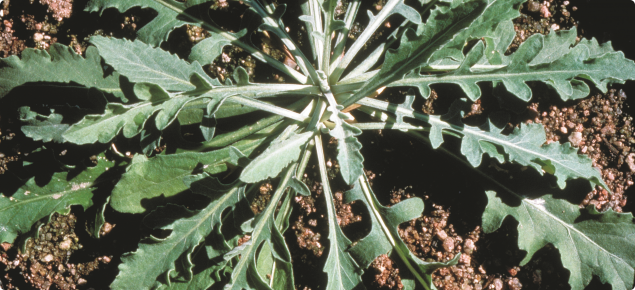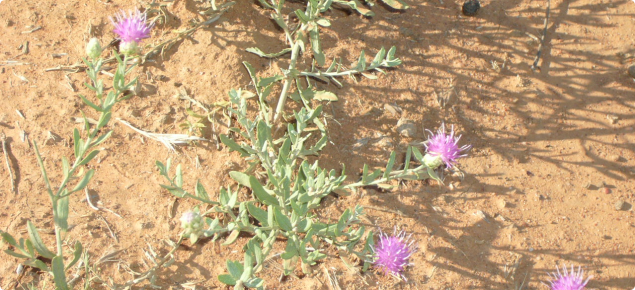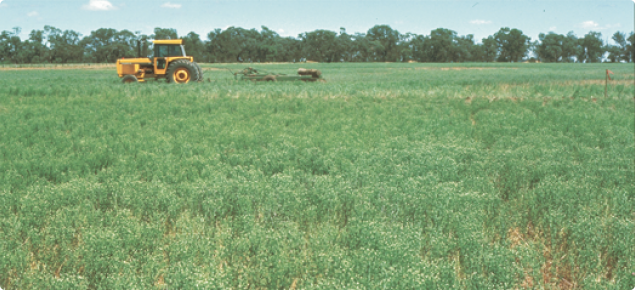Form: herbaceous — perennial
Status: not present in WA
Native from eastern Europe to Mongolia; also known as Russian knapweed, and hardhead thistle.
Appearance
An erect perennial herb growing 40-100 centimetres high and reproducing from creeping roots (rhyzomes) or seed. Winter dormant. Seedlings form rosettes in spring, develop a deep root system, and flower the following summer. Plants spread by creeping roots often form large colonies.
Stems: branched, young stems covered with dense soft grey hairs.
Leaves: rosette leaves are silvery green when young, greyish green later and slightly hairy, 15 centimetres long and two to five centimetres wide, toothed and irregularly lobed on older rosette leaves. Stem leaves are similar to rosette leaves on the lower stem, but are shorter on the upper stem, are not carried on short stalks, only slightly toothed and are arranged alternately along the stem.
Flowers: flower-heads are to 2.5 centimetres diameter, borne singly at the end of branches. Made up of purple, lilac or pink florets, rarely white. Bracts surrounding the flower heads are broad, white and papery thin with dense hairs at the tips.
Seed: ivory white, sometimes mottled, egg shaped three to four millimetres long, two to three millimetres wide, with a pappus of stiff barbed hairs ranging from one half to twice the length of the seed.
Online weed identification training
Login or set up a new account on DPIRDs online training site to access:
- a training course on how to identify creeping knapweed and report it.
- training material that you can use to teach community groups how to identify creeping knapweed.
Agricultural and economic impact
Weed of horticultural and cereal crops, roadsides and wasteland. Creeping knapweed is a deep-rooted perennial that can dramatically reduce the yield of grain crops. It can also infest pastures, orchards, vineyards and other horticultural crops. It is not beneficial to livestock and is toxic to horses.
Declared pest category
The Western Australian Organism List (WAOL) contains information on the area(s) in which this pest is declared and the control and keeping categories to which it has been assigned in Western Australia. Search for creeping knapweed in the WAOL using the scientific name Rhaponticum repens.
Requirements for land owners/occupiers and other persons
Requirements for land owners/occupiers and other persons if this pest is found can be sourced through the declared plant requirements link.
Search > detect > report
| MyPestGuide™ Reporter | Pest and Disease Information Service (PaDIS) |
Detectability: medium difficulty to find. Creeping knapweed resembles a spine-free thistle. It has erect branched stems up to one metre tall. Both stems and leaves are slightly woolly in appearance. The leaves are grey-green. The flowers are usually purple but sometimes pink or white. They are about 2.5 ccentimetres in diameter and form singly at the ends of branches.
Who is likely to find it: any farmers or other landholders in the Ravensthorpe area, members of the grains industry, sheep farmers, orchardists, viticulturists, vegetable growers and horse owners.
When to find it: it is most likely to be noticed when flowering, in early summer.
Where to find it: creeping knapweed has only been found once in WA. In the Eastern States and other countries, creeping knapweed invades crops, pastures, orchards and vineyards. It is most likely to be found in the higher rainfall parts of the southwest
Control method
Report the presence of this organism before undertaking a control measure. Control methods for this declared plant can be found through the creeping knapweed control link.
Management calendar
(a faded icon means Occasionally)
Further information
Further information on creeping knapweed can be found on the creeping knapweed: what you should know page.





